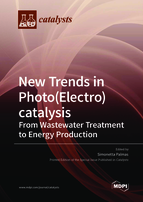New Trends in Photo(Electro)catalysis: From Wastewater Treatment to Energy Production
A special issue of Catalysts (ISSN 2073-4344). This special issue belongs to the section "Photocatalysis".
Deadline for manuscript submissions: closed (30 April 2020) | Viewed by 84571
Special Issue Editor
Interests: preparation and characterization of catalysts for redox processes; synthesis and characterization of semiconductor nanostructured materials; synthesis of TiO2 nanotubes; advanced oxidation processes for the demolition of biorefractory organics and wastewater treatment; application of photoelectrocatalytic processes in the energetic and environmental field
Special Issues, Collections and Topics in MDPI journals
Special Issue Information
Dear Colleagues,
Remediation of wastewater, up to a level acceptable for discharge into receiving waterbodies, involves an ever-growing demand of energy, so effective and low energy use demand treatment processes that are highly desirable
Among the others, photo and photo-electrochemical treatment processes may be considered as advanced oxidation processes (AOP), which are based on the generation of OH radicals, strong oxidizing agents able to indiscriminately degrade even the most persistent organic compounds.
Photocatalysis, which exploits the semiconductor material’s ability to generate electron-hole coupling, under the irradiation of a suitable wavelength, can be considered as an effective method for organic degradation, especially when the semiconductor is active in the range of visible light.
Greater efficiencies may be obtained in photo-electrocatalytic processes, thanks to the application of an electric field, which assists the displacement of electrons within the semiconductor structure, thus reducing the recombination between photo-generated charges, which represents one of the main drawbacks of this process.
This Special Issue aims to focus on new trends in photo-electrocatalysis, not only for aspects related to possible advances in materials science, but also to new possible applications of the technology. Actually, we may consider the different philosophies that have been prevailing in these last few years: rather than considering the wastewater treatment process as just a way to destroy or remove organics from waste, the pollutants may be considered as a source of energy, so that the electrons produced by the oxidative process could be recovered and possibly used to obtain new chemicals and fuels.
Thus, research on new morphologies and structures, which allow more photoactive, visible responsive, and stable materials will be welcome, as well as studies on combined processes in which photo- or photo-electrochemistry contributes to an increase in the sustainability of the whole process, in terms of lowering costs and achieving the most valuable final products.
Prof. Simonetta Palmas
Guest Editor
Manuscript Submission Information
Manuscripts should be submitted online at www.mdpi.com by registering and logging in to this website. Once you are registered, click here to go to the submission form. Manuscripts can be submitted until the deadline. All submissions that pass pre-check are peer-reviewed. Accepted papers will be published continuously in the journal (as soon as accepted) and will be listed together on the special issue website. Research articles, review articles as well as short communications are invited. For planned papers, a title and short abstract (about 100 words) can be sent to the Editorial Office for announcement on this website.
Submitted manuscripts should not have been published previously, nor be under consideration for publication elsewhere (except conference proceedings papers). All manuscripts are thoroughly refereed through a single-blind peer-review process. A guide for authors and other relevant information for submission of manuscripts is available on the Instructions for Authors page. Catalysts is an international peer-reviewed open access monthly journal published by MDPI.
Please visit the Instructions for Authors page before submitting a manuscript. The Article Processing Charge (APC) for publication in this open access journal is 2700 CHF (Swiss Francs). Submitted papers should be well formatted and use good English. Authors may use MDPI's English editing service prior to publication or during author revisions.
Keywords
- Photoelectrocatalytic wastewater treatment
- Photoelectrocatalytic degradation of organics
- Nanostructured semiconductors
- Visible light sensitive semiconductors
- Wastewater sustainable combined processes
- Advanced electrochemical oxidation processes
- Bioelectricity
- Photoelectrosyntesis
- H2 production






